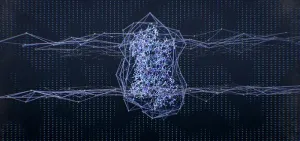(Press-News.org) Vision is a complex process. The visual perception of the environment is created by a combination of different wavelengths of light, which are decoded as colours and brightness in the brain. Photoreceptors in the retina first convert the light into electrical impulses: with sufficient light, the cones enable sharp, detailed, and coloured vision. Rods only contribute to vision in low light conditions allowing for different shades of grey to be distinguished but leaving vision much less precise. The electrical nerve impulses are finally transmitted to ganglion cells in the retina and then via the optic nerve to the visual cortex in the brain. This region of the brain processes the neural activity into a coloured image.
What influences the internal clock?
Ambient light however does not only allow us to see, it also influences our sleep-wake rhythm. Specialised ganglion cells are significantly involved in this process, which - like the cones and rods - are sensitive to light and react particularly strongly to short-wavelength light at a wavelength of around 490 nanometres. If light consists solely of short wavelengths of 440 to 490 nanometres, we perceive it as blue. If short-wavelength light activates the ganglion cells, they signal to the internal clock that it is daytime. The decisive factor here is how intense the light is per wavelength; the perceived colour is not relevant.
"However, the light-sensitive ganglion cells also receive information from the cones. This raises the question of whether the cones, and thereby the light colour, also influence the internal clock. After all, the most striking changes in brightness and light colour occur at sunrise and sunset, marking the beginning and end of a day," says Dr. Christine Blume. At the Centre for Chronobiology of the University of Basel, she investigates the effects of light on humans and is the first author of a study investigating the effects of different light colours on the internal clock and sleep. The team of researchers from the University of Basel and the TUM has now published its findings in the scientific journal "Nature Human Behaviour".
Light colours in comparison
"A study in mice in 2019 suggested that yellowish light has a stronger influence on the internal clock than blueish light," says Christine Blume. In humans, the main effect of light on the internal clock and sleep is probably mediated via the light-sensitive ganglion cells. "However, there is reason to believe that the colour of light, which is encoded by the cones, could also be relevant for the internal clock."
To get to the bottom of this, the researchers exposed 16 healthy volunteers to a blueish or yellowish light stimulus for one hour in the late evening, as well as a white light stimulus as a control condition. The light stimuli were designed in such a way that they differentially activated the colour-sensitive cones in the retina in a very controlled manner. However, the stimulation of the light-sensitive ganglion cells was the same in all three conditions. Differences in the effect of the light were therefore directly attributable to the respective stimulation of the cones and ultimately the colour of the light.
"This method of light stimulation allows us to separate the light properties that may play a role in how light effects humans in a clean experimental way," says Manuel Spitschan, Professor of Chronobiology and Health at the Technical University of Munich, who was also involved in the study.
In order to understand the effects of the different light stimuli on the body, in the sleep laboratory the researchers determined whether the internal clock of the participants had changed depending on the colour of the light. Additionally, they assessed how long it took the volunteers to fall asleep and how deep their sleep was at the beginning of the night. The researchers also enquired about their tiredness and tested their ability to react, which decreases with increasing sleepiness.
Ganglion cells are crucial
The conclusion: "We found no evidence that the variation of light colour along a blue-yellow dimension plays a relevant role for the human internal clock or sleep," says Christine Blume. This contradicts the results of the mouse study mentioned above. "Rather, our results support the findings of many other studies that the light-sensitive ganglion cells are most important for the human internal clock," says the scientist.
Manuel Spitschan sees the study as an important step towards putting basic research into practice: "Our findings show that it is probably most important to take into account the effect of light on the light-sensitive ganglion cells when planning and designing lighting. The cones and therefore the colour play a very subordinate role."
It remains to be seen whether the colour of the light also has no effect on sleep if the parameters change and, for example, the duration of the light exposure is extended or takes place at a different time. Follow-up studies should answer questions like these.
CONTEXTBOX
Night mode on screens - useful or not?
We often hear that the short-wavelength component of light from smartphone and tablet screens affects biological rhythms and sleep. The recommendation is therefore to put your mobile phone away early in the evening or at least use the night shift mode, which reduces the short-wavelength light proportions and looks slightly yellowish. Christine Blume confirms this. However, the yellowish colour adjustment is a by-product that could be avoided. "Technologically, it is possible to reduce the short-wavelength proportions even without colour adjustment of the display, however this has not yet been implemented in commercial mobile phone displays," says the sleep researcher.
END
Light colour is less important for the internal clock than originally thought
2023-12-22
ELSE PRESS RELEASES FROM THIS DATE:
Scientists develop ‘flying dragon’ robot to fight fires from a distance
2023-12-22
Imagine a flying dragon that doesn’t spout fire, but instead extinguishes it with blasts of water. Thanks to a team of Japanese researchers, this new kind of beast may soon be recruited to firefighter teams around the world, to help put out fires that are too dangerous for their human teammates to approach.
The blueprint of this novel firefighter robot, called the Dragon Firefighter, has now been published in Frontiers in Robotics and AI. And as it has been published as Open Science, roboticists around the world may freely ...
Sunday sales reign supreme and other takeaways from review of farmers market transactions
2023-12-21
CORNELL UNIVERSITY MEDIA RELATIONS OFFICE
FOR RELEASE: Dec. 21, 2023
Kaitlyn Serrao
607-882-1140
kms465@cornell.edu
ITHACA, N.Y. – Cornell researchers partnered with New York livestock farmers to analyze transactions at farmers markets, finding that sales were better on Sundays, early in the morning, and during certain months of the year. The study, which researchers believe is the first peer-reviewed analysis of customer-level transaction data at farmers markets, gives new insights into how farmers can make markets more profitable for them.
The researchers and farmers used point-of-sale devices that record sales ...
Palliative care is underused for patients with malignant urinary obstruction
2023-12-21
Less than half of patients with malignant ureteral obstruction (MUO) – a serious complication of advanced cancer, with a poor prognosis – receive palliative care (PC) for their condition, reports a paper in the January issue of Urology Practice®, an Official Journal of the American Urological Association (AUA). The journal is published in the Lippincott portfolio by Wolters Kluwer.
Hospice care can promote patient comfort while avoiding aggressive and invasive treatments for MUO patients nearing the end ...
JCEHP supplement aims to disrupt assumptions about continuing professional development
2023-12-21
December 7, 2023 —The Journal of Continuing Education in the Health Professions (JCEHP) has published a supplement, "Conceptual Advances in Continuing Professional Development in the Health Professions," in which scholars of continuing professional development (CPD) creatively examine prevailing assumptions and propose new theoretical frameworks and empirical insights. Publication of the supplemental issue is supported by the Society for Academic Continuing Medical Education (SACME). JCEHP, the official journal of the Alliance for Continuing Education in the Health Professions, ...
Researchers awarded $3 million to develop AI to better detect aggressive prostate cancer
2023-12-21
Researchers at the UCLA Health Jonsson Comprehensive Cancer Center have received a five-year, $3 million grant from the National Cancer Institute to identify novel cancer biomarkers and develop AI that can detect and predict aggressive prostate cancer to help avoid unnecessary treatments and their associated negative side effects.
Despite recent advancements, prostate cancer remains a common and serious health issue for men, and current methods of screening and risk assessment can often lead to overdiagnosis and overtreatment. About 90% of people diagnosed with prostate cancer receive treatment, even though ...
GPCR structure: Research reveals molecular origins of function for a key drug target
2023-12-21
Through an international collaboration, scientists at St. Jude Children’s Research Hospital leveraged data science, pharmacology and structural information to conduct an atomic-level investigation into how each amino acid in the receptor that binds adrenaline contributes to receptor activity in the presence of this natural ligand. They discovered precisely which amino acids control the key pharmacological properties of the ligand. The adrenaline receptor studied is a member of the G protein-coupled receptor (GPCR) family, and this family is the target of one-third of all Food and Drug Administration (FDA)-approved drugs. Thus, understanding how ...
Structures of Parkinson’s disease-linked proteins offer a framework for understanding how they work together
2023-12-21
Scientists at St. Jude Children’s Research Hospital revealed the complex structure of two Parkinson’s disease-related proteins, both of which are implicated in late-onset cases. Leucine-rich repeat kinase 2 (LRRK2) is a protein kinase that modifies other proteins in a process called phosphorylation; Rab29, a member of the Rab GTPase family that regulates cellular trafficking, modulates the activity of LRRK2. How Rab29 and LRRK2 work synergistically to cause Parkinson’s disease remains ...
Male breast cancer diagnosis fuels groundbreaking treatment tool
2023-12-21
Doctors diagnosed Christopher Gregg, Ph.D., member of the Nuclear Control of Cell Growth and Differentiation Program at Huntsman Cancer Institute at the University of Utah (the U) and neuroscientist and professor of neurobiology and human genetics at the U, with stage 4 metastatic breast cancer in 2018. At that point, he started thinking of ways to improve his treatment.
“The core problem of metastatic cancer is it evolves,” says Gregg. “There may be a treatment that works today but eventually ...
NASA’s Hubble watches ‘spoke season’ on Saturn
2023-12-21
This photo of Saturn was taken by NASA's Hubble Space Telescope on October 22, 2023, when the ringed planet was approximately 850 million miles from Earth. Hubble's ultra-sharp vision reveals a phenomenon called ring spokes.
Saturn's spokes are transient features that rotate along with the rings. Their ghostly appearance only persists for two or three rotations around Saturn. During active periods, freshly-formed spokes continuously add to the pattern.
In 1981, NASA's Voyager 2 first photographed the ring spokes. NASA's Cassini orbiter also saw the spokes during its 13-year-long mission that ended in 2017.
Hubble continues ...
Astronomers detect seismic ripples in ancient galactic disk
2023-12-21
A new snapshot of an ancient, far-off galaxy could help scientists understand how it formed and the origins of our own Milky Way.
At more than 12 billion years old, BRI 1335-0417 is the oldest and furthest known spiral galaxy in our universe.
Lead author Dr Takafumi Tsukui said a state-of-the-art telescope called ALMA allowed them to look at this ancient galaxy in much greater detail.
“Specifically, we were interested in how gas was moving into and throughout the galaxy,” Dr Tsukui said.
“Gas is a key ingredient for forming stars and can give ...





